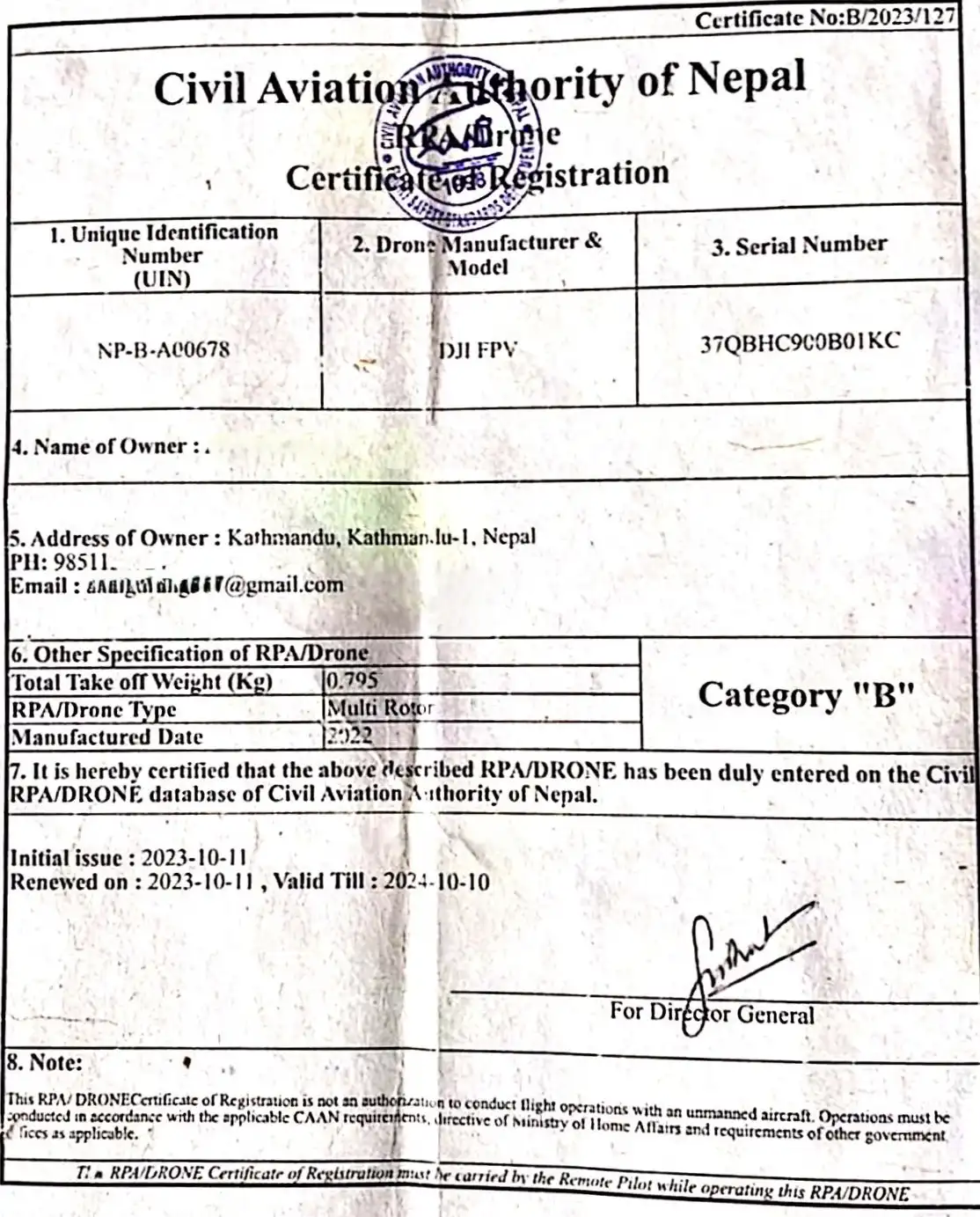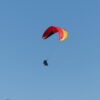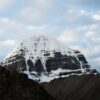Drone Permits in Nepal: Step-by-Step Guide, Costs & Essential Tips
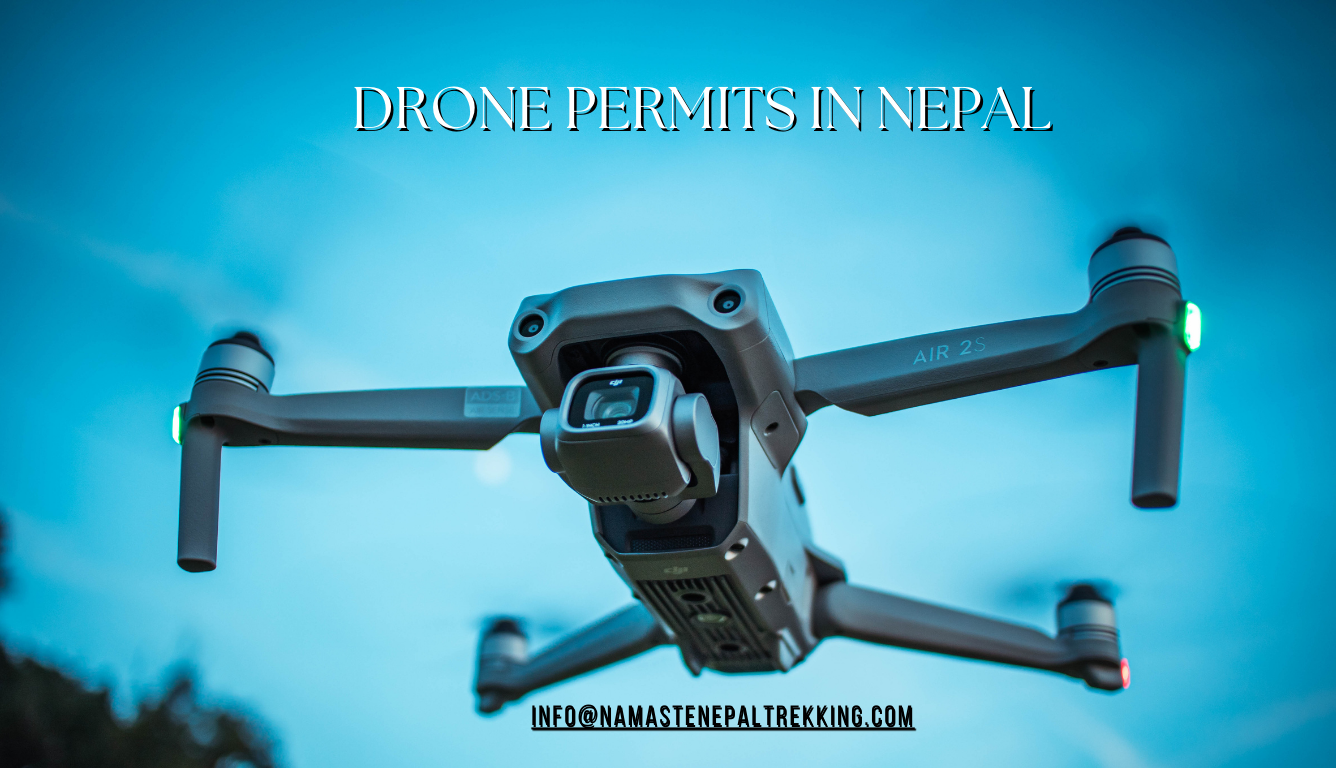
Introduction: Drone Permits In Nepal
Drone technology is rapidly expanding across different regions within Nepal because of its beautiful landscapes alongside diverse topography. The use of drones brings multiple advantages to users who need to record breathtaking aerial shots for tourism promotion, alongside disaster response and survey efforts.
The exclusive advantage of drone operation in Nepal enables photographers to discover extraordinary views while documenting breathtaking natural vistas. Obtaining a drone license requires you to maintain responsible drone practices that protect safety as well as show respect to others and follow the guidelines.
Additional to personal safety, compliance with Civil Aviation Authority of Nepal (CAAN) rules is necessary to maintain both privacy rights and community rights. Your objective should be safety during every flight, along with careful observance of local customs and strict avoidance of restricted areas.
The regulations which govern drone usage in Nepal present complexity to users. The operation of drones without valid authorizations will result in severe monetary penalties together with potential equipment seizure as well as potential legal consequences.
The safe operation of drones in Nepal requires that all users understand and consistently follow established regulations since this framework protects both people and communities.
Proper drone usage serves two benefits: it supports easier operation and simultaneously builds positive relationships with residents and regulations. Your security and the security of future drone operations will remain possible in Nepal through this practical method.
The step-by-step procedure for obtaining drone permits in Nepal with a full cost analysis and useful guidelines for safe legal operations are presented within this complete guide.
Additionally, follow these guidelines when operating your Drone regardless of your purpose, whether it be creating aesthetic documentation fu, fundamental research or recreational activities. Thriving while being cautious is the key to responsible flying heights.
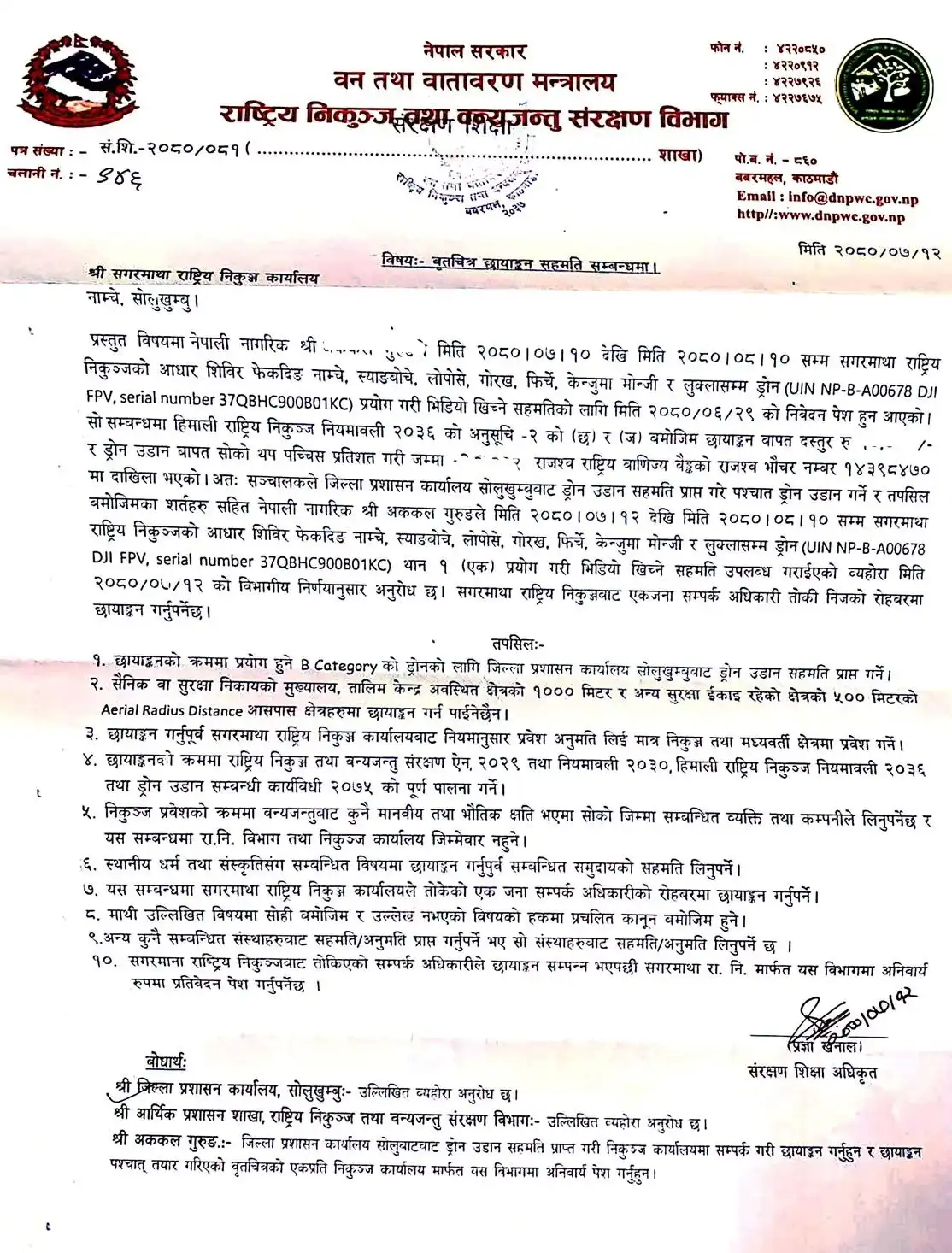
Quick Overview of Drone Laws in Nepal
Before using the Drone in Nepal it is essential to know the Drone laws in Nepal. Let’s get familiar with the rules so that it will be helpful to fly responsibly and avoid potential issues.
Registration and Permission: All drones that fly in Nepal must be registered with the Civil Aviation of Nepal(CAAN). Those who operate the Drone must get permission to fly, especially if they are using it for commercial purposes.
Weight Categories: Drones are categorized based on weight:
| Drone Type | Risk | Weight |
| Category A | “Very Low Risk” Operations | Less than 250 gram |
| Category B | “Low Risk” Operations | 250 gramm to 2 Kg |
| Category C | “Regulated Low Risk” Operations | 2 Kg to 25 Kg |
| Category D | “Regulated High Risk” Operations | Above 25 Kg |
Note: Each Drone, which is categorized according to weight, has specific operational guidelines.
Restricted Zones: Flying drones is prohibited in certain areas, such as:
- Inside the airport or near the airport areas: Within 5 km of any airport or landing strip)
- International boundaries: Within 5 km of the international boundary
- Government buildings: Within 1 km of the President, Vice-President, PM, and VVIP offices and residences
- Military installations: Inside the military or near the military area
- Heritage sites: Within 1 km of religious, heritage, and sacred sites
- National parks: Over national parks, such as the Sagarmatha National Park and the Chitwan National Park
- Residential areas: Over residential areas, near people, vehicles, or buildings
- Conflict zones: Places where there is a land dispute, a conflict, or a war.
- Altitude and Distance: Drones must stay within the operator’s line of sight and not fly higher than 400 feet.
- Privacy and Safety: Operators are required to protect privacy and prevent it from putting individuals or property in danger.
What Happens if You Fly a Drone in Nepal Without Permission?
Legal Penalties
- Operating a drone without proper authorization violates Nepal’s aviation laws and is considered a crime in Nepal.
- You may face fines or legal action, including possible detention.
Drone Confiscation
- Authorities may seize your Drone if it is flown illegally.
- Getting it back can involve lengthy procedures, or you may lose it permanently.
Financial Repercussions
- You could incur significant fines for breaching drone regulations.
- Additional costs may arise if you are required to pay for legal defence or penalties.
Operational Restrictions
- Flying without permission can lead to a ban on future drone operations in Nepal.
- Your name may be blacklisted for any future authorization requests.
Safety Risks
- Unauthorized flights can endanger public safety or disrupt aviation activities.
- Accidents caused by illegal operations can result in serious consequences for others and damage your reputation.
Therefore, all people, including foreigners who want to fly drones in Nepal, must obtain a drone permit and follow all the rules and regulations mentioned by the CAAN.
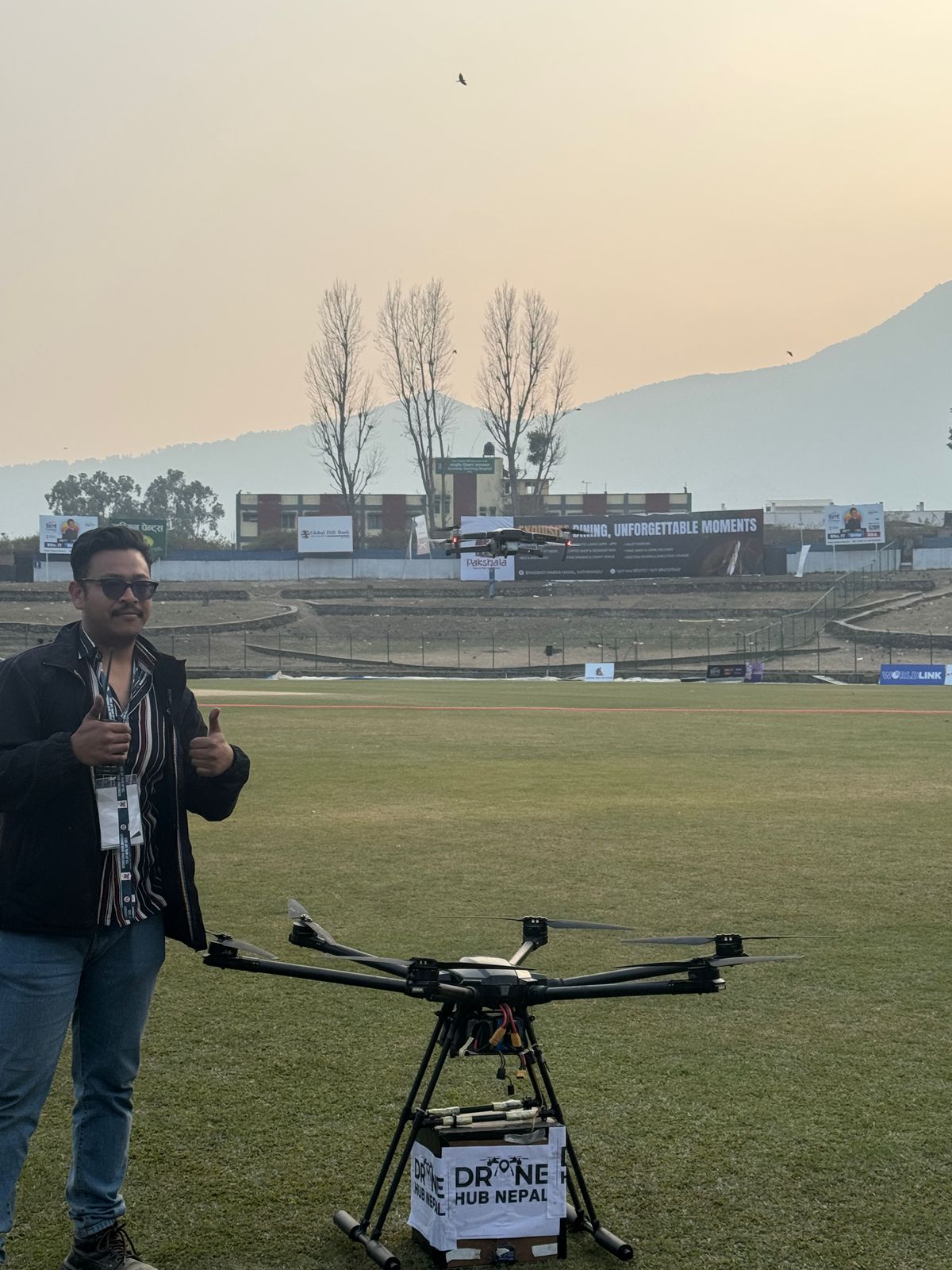
The Permit Application Process:
Getting a permit is necessary in order to legally operate a drone in Nepal. The procedure guarantees safe drone operation and legal compliance. Important paperwork must be prepared, an application must be filled out, costs must be paid, and the Civil Aviation Authority of Nepal (CAAN) must be consulted before approval may be granted. You can obtain the permit and fly safely if you carefully follow these instructions.
Step 1: Prepare Your Documents
Gather the following essential documents needed to apply for a drone permit:
- Photographs of the Drone (clear images showing the equipment from multiple angles).
- A copy of your passport (for identity verification).
- Drone specifications document (technical details and manufacturer information).
- Purpose of use (a written statement describing why you intend to fly the Drone — such as photography, videography, surveys, etc.).
- Any additional documents, such as company verification letters (for commercial purposes).
Step 2: Contact the Civil Aviation Authority of Nepal (CAAN)
The main organization in charge of drone regulation in Nepal is the CAAN. For the most recent details on drone laws and necessary paperwork, you can visit their official website or get in touch with their office. Their official website is https://caanepal.gov.np/drone.
Step 3: Download or Collect the Permit Application Form
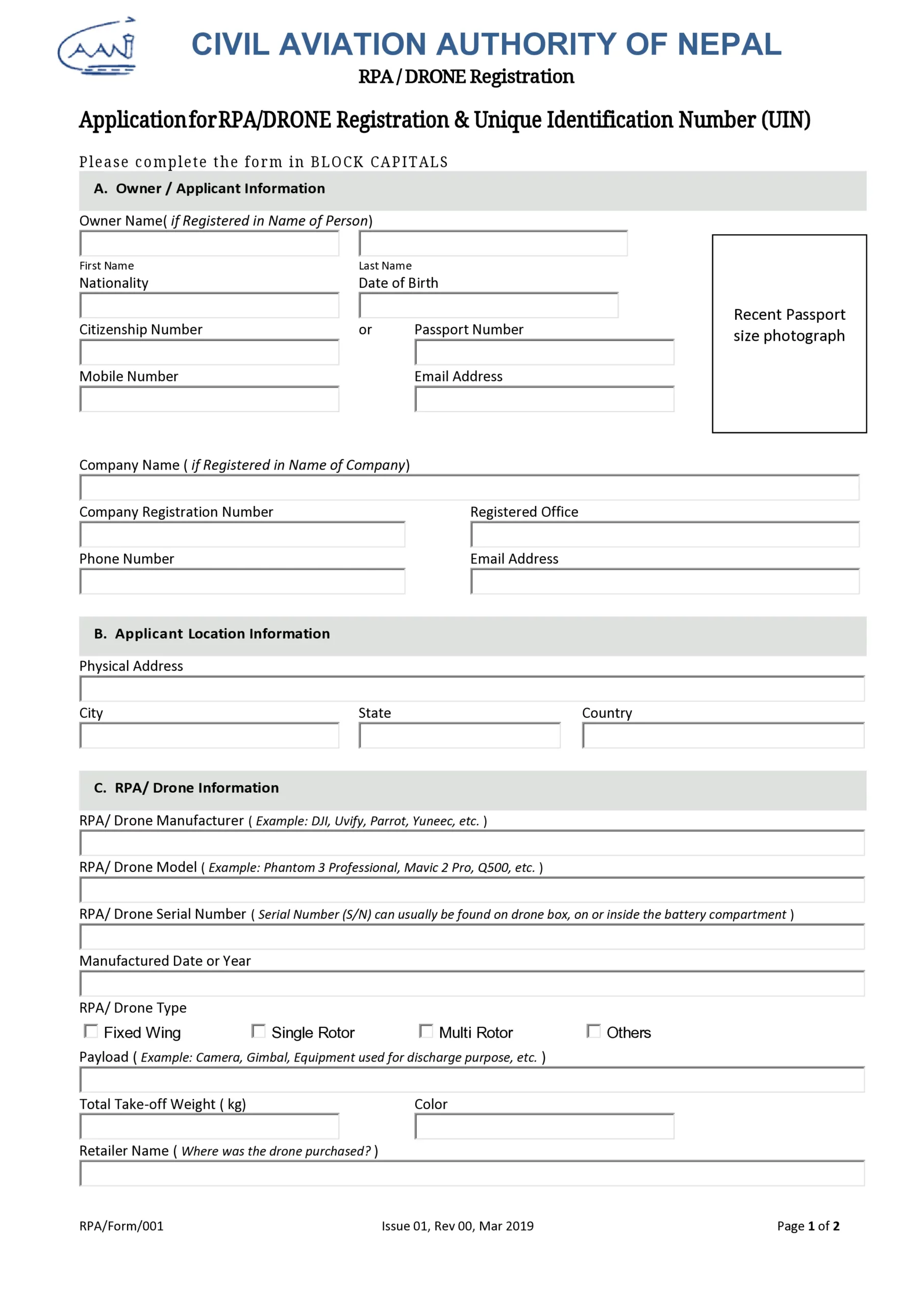
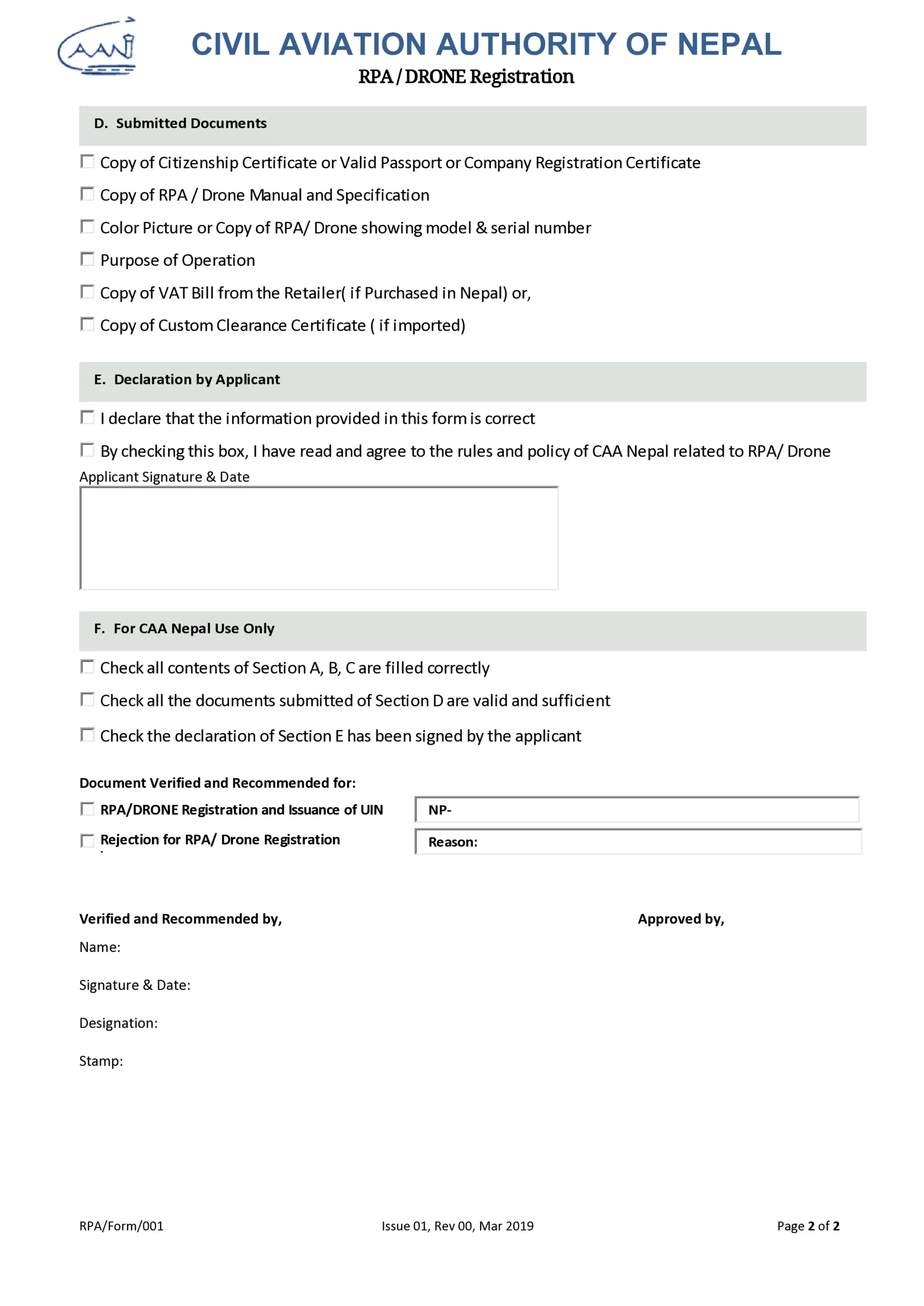
- You can find the Drone Permit Application form on the CAAN website. You can download the form from the download section, which is 2 pages. Here is the link: Purpose of Operation and Commitment Letter
- If you cannot access the form from the CAAN website, you can directly visit the office to get a physical copy. Can location: https://maps.google.com/maps
Step 4: Fill Out and Submit the Form
- Once you download the form, fill the form accurately by keeping all your details and drone information and the purpose of Drone use.
- After that, you need to attach the required documents with the form, like photos, passport copy, purpose statement, etc.
Step 5: Pay Required Fees
- After you fill out the form, you need to pay the application fees. You can make the payment either by Connecting IPS or through a bank deposit. The registration fee is USD 50 (plus 13% VAT).
Step 6: Wait for Approval
- Once you submit the registration application, CAAN will review your application. To get the approval, it might take a few days or even weeks, depending upon the complexity of your case. For updates, could you keep in contact with their office
Here is the CAAN official number and email:
- Mail: [email protected]
- Contact number: 01-977-015718030/31
Step 7: Receive Your Permit
- After you get approval, you need to visit the Flight Safety Standard Department at Sinamangal, Kathmandu, to obtain the permit. After you obtain the permit, you are allowed to operate your Drone legally in Nepal by following the guidelines provided.
How Much Does It Really Cost For Drone Permit Fees?
If you are curious about how much it costs for a drone permit in Nepal, here is the detailed information.
Permit Costs by Drone Size and Purpose
The cost of a drone permit in Nepal depends on the size of the Drone and its intended purpose. If you are using the Drone solely for personal purposes, it weighs less than two kilograms, and it is flown under 200 feet above the ground within a private space, you do not need to obtain a permit. However, for all other cases, including flying in areas outside private spaces or for commercial purposes, a permit is required. The permit fee is USD $50, plus an additional 13% VAT.
Drone Permit Cost For National Park or Conservation Area
- Drone Registration & Unique Identification Number (UIN) fee: $50+13% VAT
- Permit for Nepalese: NPR 12,500 (around $95)
- Permit for SAARC nationals: NPR 50,000 (around $400)
- Permit for Foreigners: $1800
On top of the above-mentioned cost, we need to pay to the following authorities, depending on the area you are flying involved:
- For the Communication Ministry: NPR 15000
- For the Foreign Ministry: NPR 15000
- Nepal Army Clearance: NPR 12500
- Approval from the Chief District Officer: Depends
- Home Ministry Permission: Depends
- Service Charge and Documentation fee: Depends
Note: Getting the drone permit for commercial use is lengthy due to several steps involved. Drone permits vary in price depending on where you fly them. For example, flying in national parks, conservation zones, airport areas, and heritage sites requires a separate permit.
Things to Know While Paying the Drone Permit Fees
- Since drone permit costs are non-refundable, make sure all application details are correct.
- To avoid fraud, confirm the official payment methods, whether via an online portal or a designated office.
- For future use and as evidence of the transaction, keep a copy of your payment receipt.
- Before paying your charge, make sure you fulfil all the requirements and include the appropriate paperwork.
How To Make a Payment for the Drone Registration / Permit?
CAAN has simplified the payment procedure for permit applications. Payments can be made using the following methods:
By Bank Deposit:
Most payments are made via designated banks. You need to deposit the fee into CAAN’s official account and submit proof of payment along with your application.
Bank Voucher Payment Details:
| Bank Account Name | Civil Aviation Authority of Nepal-1203 |
| Name of Bank | Rastriya Banijya Bank, TIA Branch |
| Address of Bank | TIA, Kathmandu |
| Bank Account No | 1090100064917001 |
By Online Payment:
You can also make an online payment for the Drone Permit fees. For this, you can use the Connecting IPS. Here are the steps to make the payment by using Connecting IPS.
- Open the Connecting IPS platform and go to the Main Screen.
- Select the More option from the menu.
- Navigate to Semi Govt. (Sansthan) and choose CAA Nepal.
- Under the branch section, select Flight Safety Standards Department-1203.
- Proceed to the PAYMENT section to complete your transaction.
Tips to Save Time and Avoid Extra Costs while Paying Drone Permit Fees
- Prepare Your Documents Carefully: Make sure that all your documents are ready while preparing. Only apply after you have completed the documents.
- Follow Regulations Strictly: Read all the rules and regulations, respect no-fly zones, and maintain proper altitude.
- Clarify Costs in Advance: If you have any confusion regarding the fee, you can contact CAAN to know the exact permit fees and if there are any additional expenses according to drone weight and purpose.

Drone Registration in Nepal.
Top 5 Tips for Getting Your Permit Approved Faster
- Start Early: Because permit processing takes enough time to analyze documents and resolve any clarification requirements, early submissions result in faster permit approval. As soon as you decide you will need drone permission, start the application process. You will have ample time to deal with any delays if you start early.
- Double-Check Everything: Carefully review your application form and all supporting documents before submission. Make sure you have included:
Clear photos of your Drone.
Accurate technical specifications.
A well-written purpose statement.
Note: Application processing delays alongside rejections may occur if your application contains errors or if some information is missing. - Be Clear About Your Purpose: CAAN requires understanding the reasons for your drone operations. To explain your drone flight’s purpose, you should present a precise description that includes photography, surveying or recreation as reasons for your flight. To enhance your application for commercial drone use, add relevant documents that demonstrate your business activities through business letters and detailed client information.
- Understand No-Fly Zones: The application guidelines for drone operations require you to know which areas in Nepal are part of no-fly zones including airport zones along with military bases and protected sites inside national parks. The application must include a statement about your knowledge of the restrictions, together with your commitment to obey them. The reassurance to CAAN confirms your status as a professional operator.
- Be Polite and Responsive to CAAN: Effective communication with CAAN officials is essential because being proper and attentive to their requests matters. Always react swiftly and professionally toward CAAN officers who need extra documentation or explanations. Earning a good professional relationship with CAAN personnel helps improve your application progress.
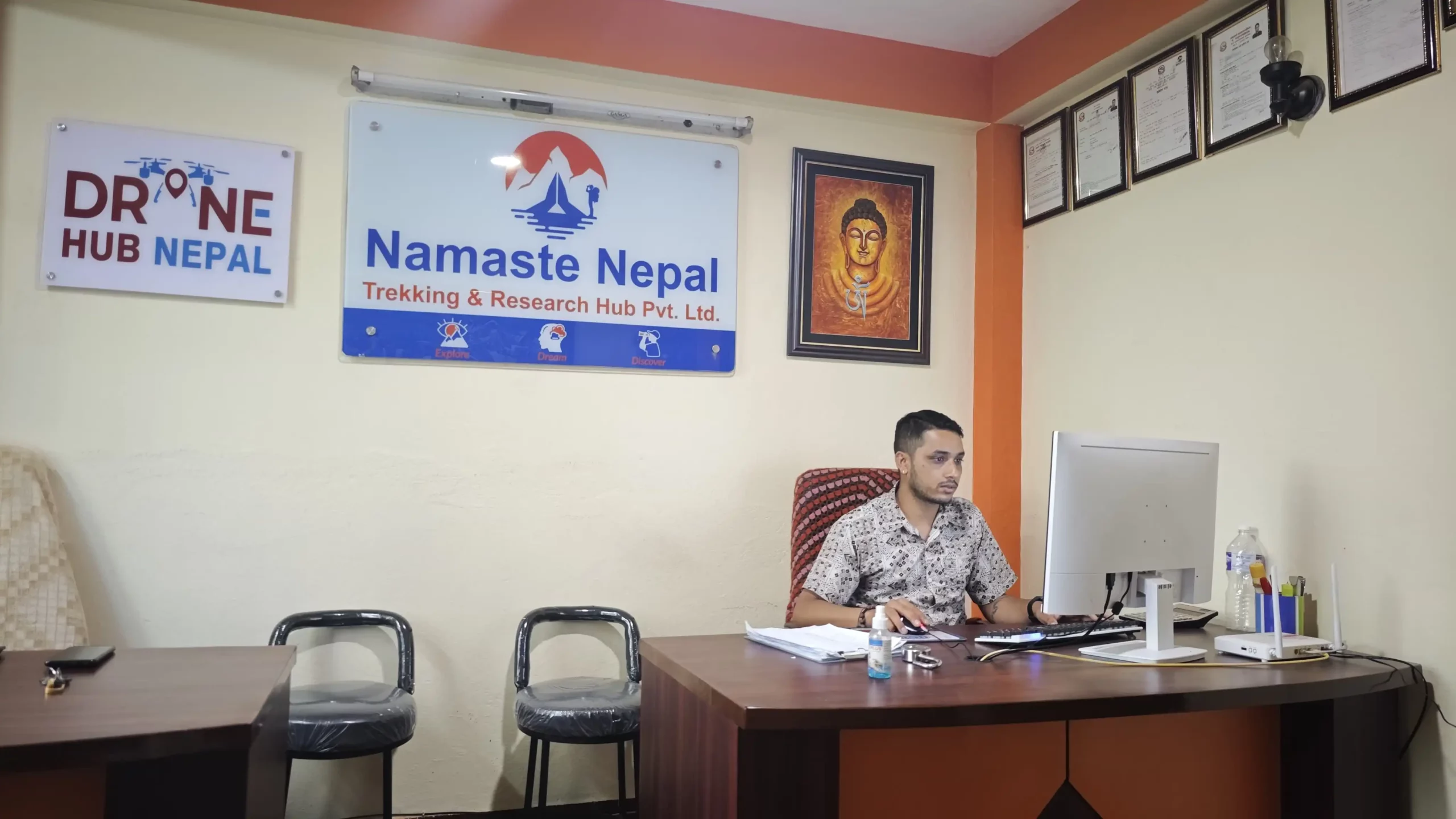
Common Mistakes to Avoid While Getting a Drone Permit
Submitting an Incomplete Application:
The most common errors in drone operation applications involve missing drone photos as well as passport copies and an unsigned purpose statement. Any missed documentation will either delay applications or lead to complete non-acceptance.
How to Avoid: The avoidance of this problem can be achieved through document checklist implementation before submission. Verify that your application contains no errors and that every piece of information is correct.
Misunderstanding Regulations:
Most applicants forget to learn the regulatory guidelines, which involve height boundaries and prohibited location restrictions. Operating beyond specified boundaries creates risks which both lead to permit denial and potential penalties.
How to Avoid: Every applicant needs to conduct an in-depth examination of the Civil Aviation Authority of Nepal (CAAN) regulations. You should double-check unclear flying instructions with CAAN both during the application process and the flight operation.
Ignoring Deadlines:
It is essential to fulfil permit applications promptly because CAAN sometimes needs extra documentation or clarification before approving applications. Apply for your application well before the deadlines because late or ignored submissions lead to automatic application rejection.
How to Avoid: Use reminder systems to notify you about submission deadlines and react quickly to any communication from the Civil Aviation Authority of Nepal (CAAN) to maintain application progress.
Being Vague About the Drone’s Purpose:
The review process will likely generate questions when you present an ambiguous or unspecific objective for your drone operation.
How to Avoid: State your drone use purpose specifically as recreational, business or research in your application. Be detailed but concise.
Failing to Account for No-Fly Zones
Applying to fly a drone in restricted areas like near airports, military zones, or national parks without proper permissions can lead to application rejection.
How to Avoid: Research no-fly zones in Nepal and ensure your plans comply. If necessary, apply for special permissions with clear justification.
Not Keeping Track of Payment Receipts:
If you lose your proof of payment documentation for permit fees, it will lead to delays in the processing time.
How to Avoid: The best way to prevent this mistake is by safely storing copies of your payments to CAAN.
Note: The successful completion of drone permit applications becomes more likely when you steer clear of these typical errors.
What to Do After You Get Your Drone Permit
Becoming a drone permit holder means you take on various responsibilities following the excitement of obtaining this document. The next steps to ensure secure and respectful flying operations include the following instructions:
1. Display Your Permit Correctly
- Keep it Accessible: Make sure to carry a copy of the permit with you while operating the Drone.
- Show it When Required: Local authorities, government bodies, and other officials can ask about the permit, so if they ask, be prepared to present the drone permit.
- Register Identification: Your Drone and the permit you get should be matched according to the registration number.
2. Follow a Pre-Flight Checklist
- Check the Weather: Avoid flying your Drone in bad weather conditions such as heavy rainfall, strong wind and fog.
- Inspect the Drone: Before flying, make sure to check the physical condition( check propellers, camera, sensor)
- Secure Your Flight Zone: Only fly in the areas where you are allowed. According to the permit, you get to fly. Avoid flying in sensitive locations.
- Test Your Controls: Check your controls to see whether it is working smoothly or not.
- Respect Altitude Limits: Fly only within CAAN’s altitude limit.
3. Respect Local Customs and Privacy
- Seek Community Permission: If you are flying into the village, temples or culturally significant landmarks such as heritage sites, you need permission from the local government body, even from police, tourism, ministry etc. So, understand the process before flying in these areas to avoid disputes.
- Avoid Surveillance Activities: Never try to capture images or videos of someone that may invade someone’s privacy.
- Stay Away from Restricted Sites: Refrain flying drones over historic sites or ceremonies without prior authorization, as many locals consider this invasive or disrespectful.
4. Follow Up on Maintenance and Insurance
- Regular Inspections: If you use your Drone a lot, make sure to keep an eye out for any hardware or software problems.
- Renew Insurance (if applicable): Drone insurance is not legally required, but having Insurance helps cover the financial risks.
5. Report Any Issues Promptly
- Document the Event: Record detailed information about what happened, including the time, location, and nature of the issue.
- Notify CAAN: Contact the Civil Aviation Authority of Nepal (CAAN) to file a formal incident report.
How can Foreigners take the Drone Permit In advance?
Getting a drone permit in Nepal can be a time-consuming process involving multiple government agencies, including the Civil Aviation Authority of Nepal (CAAN), local conservation or national park offices, the Foreign Ministry, Nepal Army, etc. That’s why it’s highly recommended to start the permit process before arriving in Nepal.
At Namaste Nepal Trekking & Research Hub, we make it easy. We offer advanced drone permit processing for foreign travelers, allowing you to fly legally as soon as you arrive. Whether you’re planning a trek to Langtang, Everest, Annapurna, or any other remote region, we handle the entire process on your behalf.
In addition to drone permits, we provide professional trekking guides and porter services, ensuring a smooth and safe journey while you focus on capturing incredible aerial footage. If you choose to trek with us, you will get the following advantages:
- Lowest permit service price in Nepal
- Permits are ready before your arrival
- Optional drone rental with permits available
- Fast, legal, and hassle-free process
For the most affordable and reliable drone permit service in Nepal, feel free to contact us directly. We’re here to help you take your trekking and drone experience to new heights—literally!
If You Need Only a Drone Permit
Here are the documents that you need to send us if you want to get the drone permit in advance.
- Scan copy of your Passport
- A visa copy (if you already have)
- The serial number of your Drone with Picture
- Full picture of your Drone (from all angles)
- Purpose of flying and Areas you want to fly
- A recent passport-size picture of a Drone Pilot
Drone Permit and Rental Options With or Without a Pilot
Foreigners who want to rent a Drone in Nepal with Namaste Nepal Trekking are welcome. Through our sister company, we provide the facility with a variety of services, including drone rentals, Drone flying training, and assistance in securing necessary permits.
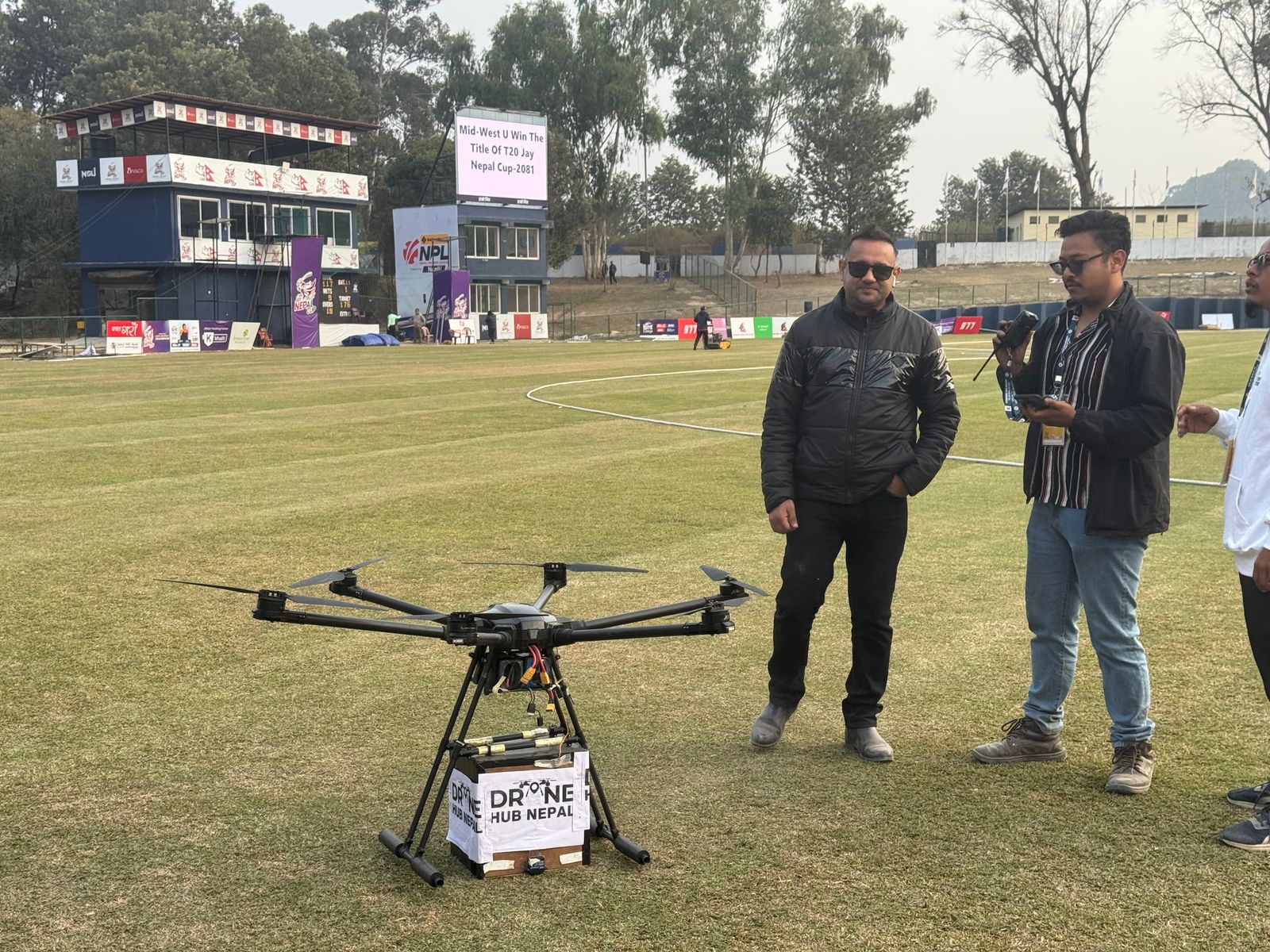
No matter if you want to fly in the beautiful Everest region, like Everest base camp or other areas, we provide you with full professional support. You can confidently fly drones in Nepal sky while adhering to legal guidelines.
Contact Details for Drone Permit & Renting
Here is our detailed Contact information so that you can contact us anytime regarding the Drone service in Nepal.
- WhatsApp, Viber & Line: +977 9843294000
- Mail: [email protected]
- Location: Amrit Marg, Thamel, Kathmandu, Nepal
Conclusion
People use drones for various purposes, and if you want to fly your Drone in Nepal, then make sure to follow the instructions set by the CAAN. Get all the permits before flying and fly only where you are allowed without breaching the law. If you have any confusion regarding the drone permits, drone rental, or hiring a drone pilot in Nepal, then you can contact us anytime.
Frequently Asked Questions on Drone Permits in Nepal
Do I need Drone Permits to fly in Nepal?
Yes, you need to obtain a Drone permit in Nepal to fly a Drone. The Civil Aviation Authority of Nepal (CAAN) will provide the drone permits after you apply for the permit by paying certain fees.
How do I apply for a drone permit in Nepal?
You can apply for the Drone permit by filling out the form sub, submitting the application with the required documents, and paying certain fees. The documents required might vary depending on the location you choose; if you want to fly in the national park and conservation areas, you need extra documents.
How much does a drone permit cost in Nepal?
The drone permit costs $50 plus 13% VAT, and for flying in restricted areas like national parks or conservation zones, the fee is NPR 12,500 (around $95) for Nepalese, NPR 50,000 (around $400) for SAARC nationals, and $1,800 for foreigners.
Where are drones allowed to fly in Nepal?
Drones are allowed to fly in Nepal only in areas permitted by the Civil Aviation Authority of Nepal (CAAN) when you obtain the required permit.
How long does it take to get a drone permit?
Getting the Drone permit in Nepal can take around 2 weeks to months, depending on the nature of the permit.
What happens if I fly a drone without a permit?
Flying a drone in Nepal is considered a crime. If you are caught flying a drone illegally in Nepal, then you will need to pay hefty fines, including jail time. Violating drone laws can lead to serious legal consequences, including being charged under laws related to security and terrorism.
Where can I find more information about drone regulations?
To know more about the Drone regulations in Nepal, you can visit the official website of CAAN (https://caanepal.gov.np/).


